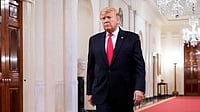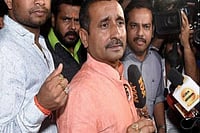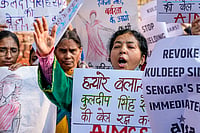It began innocuously enough. After a long steady climb upwards for over a year, the rupee seemed to be depreciating against the dollar just after mid-year. From Rs 43.37 to a dollar on August 1, the currency steadily slipped to 43.92 on September 14, 44.3 on October 3 and now to 45.84 (November 23). Some analysts, mainly foreign, have hinted at a lower band of 48 in the next few months. Does this mean that foreign investors with their deep wallets have found better pastures to graze? Will the stockmarket fall back to its mundane levels? Is the party finally, finally over?
Prompted by the falling rupee, the FIIs were net sellers of equities worth over Rs 2,250 crore in October, according to sebi. Foreign broking firms, with their forecasts of an overheated Indian economy, aided the general gloom. UBS Securities said in a report in end-October: "High growth and rising external deficits should continue to put pressure on the rupee, which could in turn lead to self-reinforcing capital outflows from equity and cash markets, forcing the currency down further." Added JM Morgan Stanley: "The virtuous cycle of strong flows, low rates, rising consumption, higher growth and strong corporate fundamentals will likely end."
Indian experts disagree, strongly. "No way," says Dharmakirti Joshi, senior economist with CRISIL, "the India story is still strong and moving investor hearts. As a result, the long-term tendency of the rupee is to appreciate." Clearly, the recent gyrations of the rupee are a result of allowing market forces to take over, especially the build-up of a current account deficit, and partly owing to build-up of seasonal expectations like the arrival of harvests, festival demand and FII profitbooking. "It's also a way of the RBI to test its resilience," feels Kanhaiya Singh, senior economist with NCAER.
Only a week ago, admitting that the currency had weakened against the dollar over the last couple of months, Union finance minister P. Chidambaram sought to assuage tremulous mediapersons saying "it's not our policy to fix a range for the rupee which is broadly market-determined. As long as the (rupee's) movements are orderly and reflect fundamentals, the government and the Reserve Bank of India are happy." And they are. Says Abheek Barua, chief economist, ABN-Amro Bank: "The RBI has been comfortable with the rupee's decline and has hardly intervened directly by selling dollars from its reserves. Nor has it attempted to talk it up with upbeat rhetoric." The RBI has a huge cushion of reserves which, though increasing much slower than last year, now stands at $142 billion. But it has intervened, if at all, only to "smoothen the trajectory", says Sanjeev Sanyal, Singapore-based director of Deutsche Bank Global Markets Research. And there are several good reasons for the RBI's not tapping the reserves—resorting to sterilisation—and instead adopting a policy of benign neglect in the exchange market.
First, the Real Effective Exchange Rate of rupee (REER), the RBI's official index, has been quite overvalued for some time. Barua estimates an overvaluation of 8.5-9 per cent in September. Explains Sanyal: "The rupee drifted stronger in real terms in the first half of 2005. As a result, it was significantly overvalued by August. The deviation from fair value reflects in the sharp deterioration in the merchandise trade balance. This was not just due to oil imports but also due to a boom in non-oil imports. The recent depreciation in the exchange rate has partly corrected the deviation in the REER. There is space for a bit more depreciation from here."
The second factor is one that's already been stressed by Chidambaram—foreign currencies like the Euro and yen have also fallen against the dollar in recent months by around 5-6 per cent. The RBI's intervention would have made the rupee stronger against these currencies and that would have hit Indian exports quite badly.
The third reason is the Indian government's endeavour to smoothen the bullish trend in the bourses. By allowing the currency to depreciate, the RBI brought about a selling spree by the FIIs and checked the runaway rise of the Sensex and the Nifty. With some more unloading expected at year-end and even in the early part of the next calendar year, assuming the rupee's fall continues, the apprehensions about India's overheated markets is likely to subside. However, despite such a logic, the Sensex has gained over a 1,000 points in a dozen trading sessions in the first half of November.
All agree that the downside story could be a temporary blip lasting at best till the budget; after all, a rising rupee affects only the inefficient exporters, and not all of them. But what if the rupee's unchecked decline ends up scaring investors, especially when US interest rates are rising, leading to a free fall of the currency at year-end? Already, a billion dollars have moved away from emerging market equities to US debt. Secondly, there is also the danger of domestic inflation piling up, with imports, including oil, getting more expensive. Can India afford stroking the inflation genie even before the government has stopped taking credit for the economy absorbing the oil price hike and keeping inflation in check?
The first possibility scares few. Says NCAER's Singh: "FIIs have shown faith in the Indian markets. They are now playing at a much higher level. So far, there had been no net inflows on a monthly basis. Debt is a different story, but when it comes to equities, Indian firms are intrinsically stronger than the US ones." However, all agree that the government has been fortunate so far, with both manufacturing and services performing exceptionally and keeping the economy going.
That phase may be coming to an end now. Although inflation has come down in the recent past, the corporates will have to start passing on the cost hikes, especially of commodities. Already, prices are creeping up in import-intensive and capital goods-intensive industries ranging from autos and consumer durables to hospitality. This will definitely result in an inflationary pressure. Dipping inflation at home has been another important factor in RBI's exchange rate policy, but now many analysts are coming out with inflation estimates of 6 per cent-plus by March. That's in keeping with the RBI average of 5 per cent for the whole year, says Joshi.
For long now, the government and the economy's credit needs (and the deficits) were being taken care of by the seemingly unending forex flows. To substitute that, as also to sustain its expanded borrowing programme for new public welfare schemes that keep tumbling out of the cupboard, the government needs to go back to the policy table with a vengeance. Of course, as Joshi points out, there are other ways to curb inflation and Chidambaram has already hinted at it. Expect a round of fiscal measures, tariff cuts et al to lessen the impact of imports. Also, the government is looking at a much improved revenue situation and many feel services can yield much more than the current 5-6 per cent of revenues without much discomfort to taxpayers.
Next year then, we could be looking at high inflation and some appreciation of the rupee. Even hardening of interest rates if inflation rises more than expected. That would not be good news for a government, already under pressure now with the Bihar results, that wants to make some difference to the life of the poor. Singh feels strongly against an interest rate hike, saying that even the small October ready-forward rate hike by the RBI was not necessary. As the rupee is poised to cross the psychological band of Rs 46 to a dollar, all eyes are focused on the RBI as well as North Block for clear indications of confidence and reforms.
Slide Show
The rupee has been slipping steadily, but panic buttons can wait just yet

Slide Show
Slide Show
Published At:
MOST POPULAR
WATCH
MORE FROM THE AUTHOR
×





















